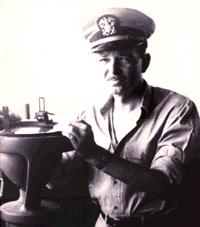Harry Hammond Hess

Harry Hammond Hess (born May 24, 1906 in New York City , † August 25, 1969 in Woods Hole , Massachusetts ) was an American geologist and one of the pioneers of the theory of plate tectonics .
Training and teaching
Hess studied at Yale University and Princeton University , where he in 1932 to Dr. phil. received his doctorate. In 1928/29 he worked as a geologist in Northern Rhodesia . In 1934 he became a professor at Princeton University and from 1950 to 1966 director of the Department of Geology there . He was also visiting professor at the South African University of Cape Town (1949-1950) and the British University of Cambridge (1965).
He was chairman of the Department of Geosciences in the National Research Council of the USA from 1955 and of the Council for Space Research of the National Academy of Sciences from 1962. From 1951 to 1953 he was President of the Geodesy Section of the American Geophysical Union , 1954/55 of the Mineralogical Society of America and 1962 President of the Geological Society of America .
Military career
Hess served in the US Navy during the Second World War and became captain of the USS Cape Johnson , a troop transport ship that was equipped with a particularly powerful echo sounder . On his voyages through the Pacific Ocean, which took him to the Mariana Islands , the Philippines and Iwo Jima , he used the echo sounder of his ship continuously. This enabled him to collect seabed profiles in the North Pacific, which led to the discovery of surf-flattened submarine volcanoes , which he called guyots . He later remained in the Naval Reserve and was promoted to Rear Admiral.
Scientific achievements

In 1960, Hess made his most important discovery, considered one of the greatest advances in geology of the 20th century. In a report to the Office of Naval Research, which was widely used, he developed the theory that the earth's crust is formed steadily along the long volcanic ocean ridges and spreads slowly from there. The discovery of the ocean floor spreading helped the widely rejected theory of continental drift by Alfred Wegener to gain scientific recognition. As a result, the geosciences turned away from fixism towards mobilism , which formed the basis for the modern theory of plate tectonics . Hess' report was published in 1962 in his History of Ocean Basins , which for a period was the most referenced work in geophysics . Hess was also involved in many other scientific endeavors, such as the Mohole Project (1957–1966), an investigation into the feasibility and technology of deep-sea drilling . The discovery of so-called seamounts - extinct or active deep-sea volcanoes - at the end of World War II can be traced back to Hess' investigations into the deep sea.
Honors
In 1966 he received the Penrose Medal of the Geological Society of America and an international Antonio Feltrinelli Prize . In 1969 he was made an honorary doctorate from Yale University , and after his death was recognized by the National Aeronautics and Space Administration (NASA) for his special services. He was a member of the National Academy of Sciences (since 1952), the American Philosophical Society (since 1960), the Accademia dei Lincei (since 1966) and the American Academy of Arts and Sciences (since 1968).
A moon crater and the Hess Mountains in Antarctica are named after Harry H. Hess . In 1977 the US Navy named one of their survey vessels , the USNS HH Hess (T-AGS-38), after him. The American Geophysical Union has been awarding the Harry H. Hess Medal since 1984 .
Works (selection)
- 1932: Hydrothermal metamorphism of an ultrabasic intrusive at Schuyler, Virginia. American Journal of Science, Vol. 26, No. 154, pp. 377-408.
- 1937: Geological interpretation of data collected on cruise of USS Barracuda in the West Indies - preliminary report. Transactions of the American Geophysical Union, 18th annual meeting, pp. 69-77.
- 1942: The floor of the north Pacific Ocean (with Frederick Betz, Jr.), pp. 99–116, American Geological Society, New York.
- 1946: Drowned ancient islands in the Pacific basin . American Journal of Science, Vol. 244, pp. 772-791.
- 1948: Major structural features of the western North Pacific, an interpretation of HO 5485, bathymetric chart, Korea to New Guinea. Bulletin of the Geological Society of America, Vol. 59, pp. 417-445.
- 1955: The oceanic crust. Journal of Marine Research, Vol. 14, pp. 423-439.
- 1959: The AMSOC Hole to the Earth's mantle. Transactions of the American Geophysical Union, Vol. 40, pp. 340-345.
- 1960: Evolution of ocean basins. Report to the Office of Naval Research. Contract No. 1858 (10), NR 081-067, 38 pp.
- 1960: Stillwater Igneous Complex, Montana, a Quantitative Mineralogical Study. Geological Society of America, Memoir No. 80, 230 pp., New York.
- 1962: History of ocean basins. In: AEJ Engel et al. (Ed.): A Volume in Honor of AF Buddington pp. 599-620, Geological Society of America, New York.
- 1965: Mid-oceanic ridges and textonics of the sea-floor. In: WE Whittard, R. Bradshaw (Eds.): Submarine Geology and Geophysics , Butterworth & Co., London.
Individual evidence
- ↑ Harry Hammond Hess (1906-1969). American Geophysical Union. Retrieved October 12, 2008
- ↑ NavSource: USNS HH Hess (T-AGS-38)
- ↑ Harry H. Hess Medal AGU (access = April 26, 2010)
Web links
- Harry Hammond Hess: Spreading the seafloor. United States Geological Survey
- Harry Hess (1906-1969) A Science Odyssey: People and Discoveries. Public Broadcasting Service
- Harry Hammond Hess Biography. Princeton University
- Harold L. James: Harry Hammond Hess (1906-1969). Detailed biography with complete list of publications (PDF, 1.1 MB)
| personal data | |
|---|---|
| SURNAME | Hess, Harry Hammond |
| BRIEF DESCRIPTION | American geologist |
| DATE OF BIRTH | May 24, 1906 |
| PLACE OF BIRTH | New York City |
| DATE OF DEATH | August 25, 1969 |
| Place of death | Woods Hole , Massachusetts |